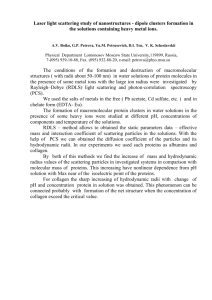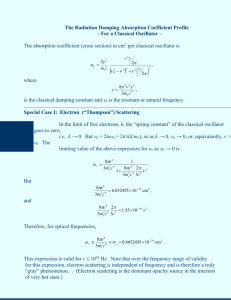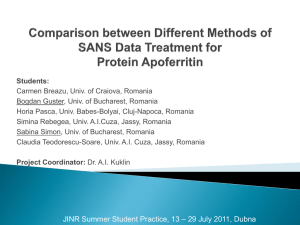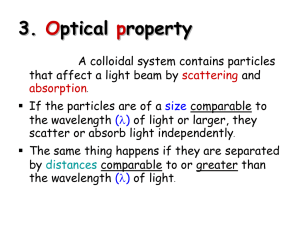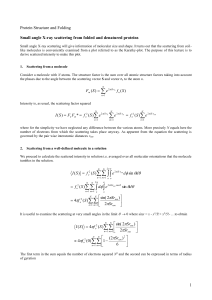See also our LS services page
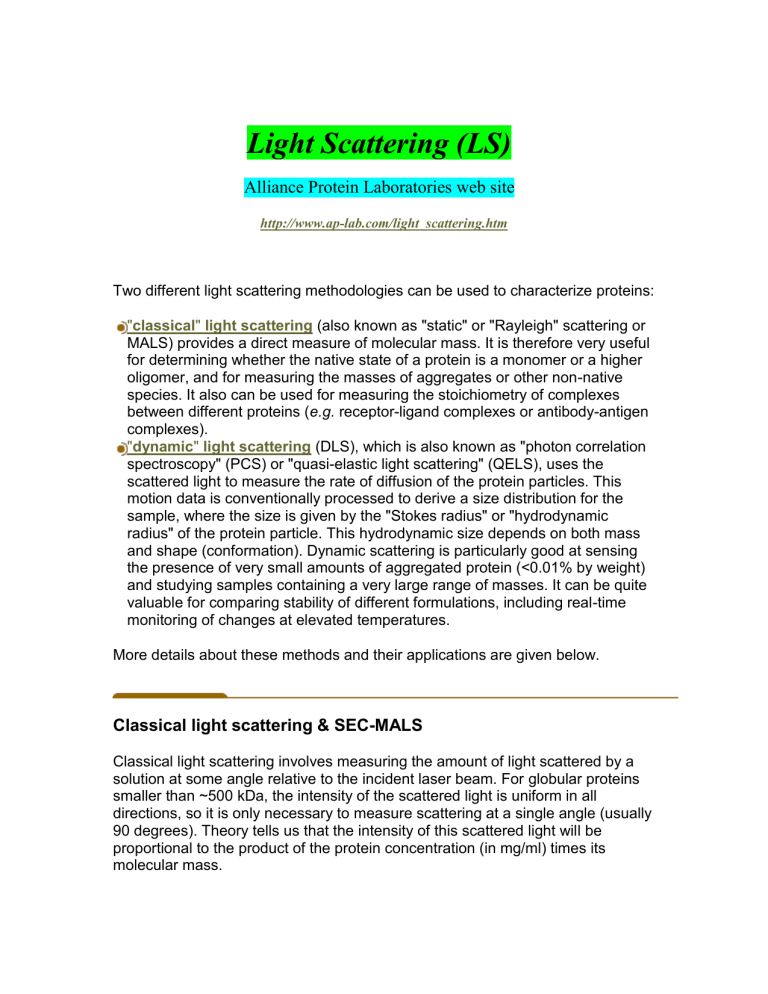
Light Scattering (LS)
Alliance Protein Laboratories web site
http://www.ap-lab.com/light_scattering.htm
Two different light scattering methodologies can be used to characterize proteins:
" classical " light scattering (also known as "static" or "Rayleigh" scattering or
MALS) provides a direct measure of molecular mass. It is therefore very useful for determining whether the native state of a protein is a monomer or a higher oligomer, and for measuring the masses of aggregates or other non-native species. It also can be used for measuring the stoichiometry of complexes between different proteins ( e.g.
receptor-ligand complexes or antibody-antigen complexes).
" dynamic " light scattering (DLS), which is also known as "photon correlation spectroscopy" (PCS) or "quasi-elastic light scattering" (QELS), uses the scattered light to measure the rate of diffusion of the protein particles. This motion data is conventionally processed to derive a size distribution for the sample, where the size is given by the "Stokes radius" or "hydrodynamic radius" of the protein particle. This hydrodynamic size depends on both mass and shape (conformation). Dynamic scattering is particularly good at sensing the presence of very small amounts of aggregated protein (<0.01% by weight) and studying samples containing a very large range of masses. It can be quite valuable for comparing stability of different formulations, including real-time monitoring of changes at elevated temperatures.
More details about these methods and their applications are given below.
Classical light scattering & SEC-MALS
Classical light scattering involves measuring the amount of light scattered by a solution at some angle relative to the incident laser beam. For globular proteins smaller than ~500 kDa, the intensity of the scattered light is uniform in all directions, so it is only necessary to measure scattering at a single angle (usually
90 degrees). Theory tells us that the intensity of this scattered light will be proportional to the product of the protein concentration (in mg/ml) times its molecular mass.
For higher masses or extended proteins (rod-like or unfolded) the scattering varies significantly with angle. By measuring the scattering at additional angles
("multi-angle light scattering", or MALS), direct absolute measurements of masses up into the MDa range can be made, and the "r.m.s. radius" (a measure of geometric size) can also be determined.
This technique is generally best used on-line in conjunction with size-exclusion chromatography (SEC-MALS), as shown in this diagram.
Since the signal from the light-scattering detector is directly proportional to the molecular mass of the protein times the concentration (mg/ml), by combining this signal with that from a concentration detector (refractive index or absorbance) it is possible to measure the molecular mass of each peak coming off the column.
Unlike conventional SEC methods, these molecular masses from light scattering are independent of the elution volume . Thus this technique can be used with "sticky" proteins that elute unusually late as a result of their interactions with the column matrix, and also with highly elongated proteins which elute unusually early for their molecular mass. The molecular masses derived by this technique are generally accurate to 3% or better.
The amount of protein required for this type of analysis is inversely related to its molecular mass. For a 20 kDa protein it is helpful to have ~100 micrograms (but often one can get by with much less). In some cases it is useful to inject quite large amounts of protein in order to get better signal/noise for the very minor peaks.
As one example, below are results from some studies of an antibody sample by
Alliance Protein Laboratories. The individual data points ( + ) show the molecular weight at each point in the chromatogram, while the solid line shows the overall elution profile as detected by the refractive index (RI) detector. These data, as expected, proved that the peak eluting around 13.4 ml is a dimer. However, the shoulder of material eluting before the dimer was unexpectedly found to also contain dimer, rather than trimer or tetramer as had been assigned based on elution position. Based on these data, as well as sedimentation velocity studies,
A.P.L. was able to show that there are two different conformations of dimer in this material.
In contrast, studies of a different antibody (below) detected very small amounts
(2.6% total) of dimer and trimer.
The amount of aggregate eluting in the region from ~12.7 to 13.6 ml (<.1%) is too small for reliable mass estimation by the traditional approach using the RI signal as the concentration reference, but A.P.L.'s own custom "oligomer hunting" software used here gives higher signal/noise and quickly reveals how many monomers are present in each aggregate peak by presenting the data as the mass ratio relative to the main peak.
This light scattering + SEC approach is also excellent for studying whether different manufacturing procedures and different lots give equivalent amounts and size distributions of aggregates. As shown below, a different lot of this same monoclonal gave a much higher total amount of aggregate and a distribution that extended to much higher mass (at least dodecamer).
This method is also very useful for characterizing conjugated molecules, like
PEGylated proteins or nucleic acids, or glycoproteins. It can identify whether the conjugation has caused the original molecule to aggregate, and also measure the extent of conjugation. APL scientists pioneered approaches for analyzing the light scattering from conjugated molecules, and APL has developed proprietary software for this type of analysis (see papers available from our Further Reading page).
Alliance Protein Laboratories has a Wyatt Technology miniDAWN™
TREOS MALS light scattering detector used together with both a refractive index detector (Wyatt
Optilab rEX) and a UV absorbance detector.
Dynamic Light Scattering
In dynamic light scattering one measures the time dependence of the light scattered from a very small region of solution, over a time range from tenths of a
microsecond to milliseconds. These fluctuations in the intensity of the scattered light are related to the rate of diffusion of molecules in and out of the region being studied (Brownian motion), and the data can be analyzed to directly give the diffusion coefficients of the particles doing the scattering. When multiple species are present, a distribution of diffusion coefficients is seen.
Traditionally, rather than presenting the data in terms of diffusion coefficients, the data are processed to give the "size" of the particles (radius or diameter). The relation between diffusion and particle size is based on theoretical relationships for the Brownian motion of spherical particles, originally derived by Einstein. The
"hydrodynamic diameter" or "Stokes radius", R h
, derived from this method is the size of a spherical particle that would have a diffusion coefficient equal to that of the protein, and the data is commonly presented as the fraction of particles as a function of their diameter.
Most proteins are certainly not spherical, and their apparent hydrodynamic size depends on their shape (conformation) as well as their molecular mass. Further, their diffusion is also affected by water molecules which are bound or entrapped by the protein. Therefore, this hydrodynamic size can differ significantly from the true physical size ( e.g.
that seen by NMR or x-ray crystallography), and this size is generally not a reliable measure of molecular mass.
One important application for DLS is measuring the hydrodynamic size of molecules that have been PEGylated to prolong serum lifetime and/or to 'hide' the molecule from the immune system or specific receptors. In such cases the increase in hydrodynamic size can be an important measure of how effective the conjugation will be in improving the product efficacy or safety. DLS directly and accurately measures the true hydrodynamic size, unlike indirect methods such as
SEC that rely on standard molecules and questionable assumptions.
Utility of DLS for studying aggregation
While dynamic scattering is, in principle, capable of distinguishing whether a protein is a monomer or dimer (their radii would be measurably different), it cannot resolve monomer from small oligomers, and cannot quantitate fractions of small oligomers. In general two different species need to differ in hydrodynamic radius by a factor of 2 or more in order for them to be resolved as separate peaks. A factor of 2 in radius corresponds to roughly factor of 8 in molecular mass! Thus typically monomer, dimer, trimer,... octamer will all be merged into one average peak. Consequently DLS is much less used for analyzing small oligomers than is SEC-MALS or sedimentation velocity .
The three key strengths of dynamic scattering are:
1. it can analyze samples containing very broad distributions of species of widely differing molecular masses ( e.g.
a native protein and various sizes of large aggregates)
2. it can detect very small amounts of the higher mass species (<0.01% in many cases).
3. because there is no chromatographic separation or dilution involved (it is a batch-mode measurement), one does not have to worry that protein aggregates are being lost within a chromatographic column or from dissociation by dilution.
Here is an example of a sample with a main component at ~2.2 nm and a clear, well-resolved aggregate peak at ~80 nm. Although this aggregate peak represents 28% of the total scattered light, because that intensity is proportional to molecular mass, and mass increases as (radius) 3 , the amount of mass represented by the aggregate is only ~0.05% of the total!
Here is the size distribution for a particularly 'bad' lot of this material, showing additional aggregate peaks at ~10 nm and ~4,000 nm, and a shift of the intermediate-size aggregate peak to somewhat larger sizes. The largest aggregate represents less than 1 part-per-million of the total mass!
A common problem with proteins is the appearance of visible particulates over time ("snow" or "floaters"). Generally these large particles grow from trace amounts of much smaller precursor aggregates. DLS can be a way (and often the only way) to detect such precursors long before visible particles are present
(which may take months). Thus this technique can provide a quick assay to help track down and prevent formation of visible particulates, and we have successfully solved such problems for a number of clients using this approach.
Another advantage of dynamic scattering is the ability to study samples directly in their formulation buffers or at high protein concentrations (50 mg/ml or more). It should be noted, however, that the interpretation of data from high concentration samples (and especially the values of the apparent hydrodynamic radius) can be quite difficult due to solution non-ideality ("molecular crowding") effects.
Nonetheless, as in the data below for a protein at over 50 mg/ml, the fact that the sample is not homogeneous and contains some large aggregate is unambiguous.
Dynamic scattering can be quite useful for assessing aggregate formation over time, and directly comparing rates of degradation for different formulations.
Accelerated stability studies can be carried out by monitoring a single sample in situ (made possible by the Peltier temperature control in our instrument) or by periodic sampling of multiple samples held at elevated temperature.
Probably the primary drawback of dynamic scattering is that it is often difficult to accurately quantitate the amount of any aggregates which may be present.
Nonetheless it can be a very good technique for relative comparisons, such as indicating which formulation, sample treatment, or purification process produces more aggregates.
Alliance Protein Laboratories has a Wyatt Technology DynaPro MS/X instrument for DLS studies, a state-of-the-art system which uses very small sample volumes
(12 microliters) and which is equipped with Peltier temperature control for accelerated stability studies.
